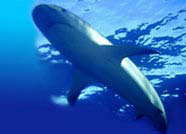


Sixgill shark

 |
 |
 |
|||
| Home | Evolution
| Classification
| Glossary | Biology
| Behavior | Shark
Repellent | Shark
Conservation | Do's &
Don'ts | Did You Know?
Sixgill shark |
 |
||||
|
 Scientific
Name: Hexanchus spp. Scientific
Name: Hexanchus spp.The Sixgill sharks are distinctive sharks that have six gills on each side of the body (most sharks have five). They include the Bluntnose Sixgill (Hexanchus griseus), the Bigeye Sixgill (Hexanchus vitulus), and the frilled shark (Chlamydoselachus anguineus). These unusual sharks also have a single (and small) dorsal fin near the end of the body. These sharks are gray-brown in color and are paler underneath. Sixgills are deep living and one of the biggest meat-eating sharks. The Bluntnose Sixgill (also known as the Cow shark, the Grey shark, the mud shark and the Bulldog shark) is a common shark about 16 ft (4.8 m) long with a toxic liver (but edible flesh) and six rows of saw-like teeth in the side of the jaws. These are cylindrical sharks of the cowshark family. Cowsharks are unusual in having six or seven gill slits, rather than the common five. The genus Hexanchus is characterized by having six gill slits. Teeth are large and comb-shaped in the lower jaw and narrow in the upper. They have one dorsal fin. The Bigeye Sixgill (also known as the lesser Sixgill and the calf shark) is about 5.9 ft (1.8 m) long, has large eyes, a slender body, five rows of saw-like teeth in the side of the jaws and lives on or near the bottom of warm temperate and tropical seas. They are found worldwide in boreal and cold temperate to tropical seas. They are deepwater sharks, usually found offshore near the bottom to depths of over 1,800m (5,900ft). They occasionally occur inshore, especially along rocky coasts or near islands, at depths of 25-50m (80-160ft). They feed on a wide range of bony fish and other large marine prey including other sharks, mammals, chimeras and rays, squid, octopus, crabs, shrimps and even seals. They also scavenge on carrion. Sixgills are ovoviviparous - eggs hatching within the mother shark - with large litters of up to around 100 pups and are not considered to be endangered. Statistics: Species vary, reaching lengths of between 1.4m (4.5ft) and 4.8m (15.5ft). Sixgill Shark Classification:
|
|||||
| Sitemap | Reach To Us | Jimtrade - Business Directory of India | |||||